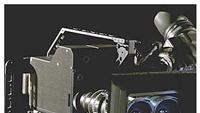Looking beyond HD for sports

There’s a lot of talk about new technologies that will add even more value to sports broadcasting, from a technical perspective. However, technologies such as 3-D and full-bandwidth HD (1080p/60) production and distribution — the equipment for which is now becoming available from a variety of vendors — are not financially practical and may not be deployed for some time.
To date, a number of trial events have offered the potential for live sports events shot in 3-D. The NBA staged an event in Las Vegas in 2007 for its 56th All-Star game at the Mandalay Bay Hotel that drew nearly 3000 people, who watched the event with special glasses. Inside the Thomas & Mack Center arena, six customized HD camera systems, each made up of two modified Sony HDC-F950 cameras with Canon HD lenses mounted side by side, were set up at different positions to capture the game action. The idea was that fans that couldn’t get tickets to their favorite teams could see them on a big screen.
Likewise, ESPN is now installing 3Gb/s-compatible infrastructure (routers, modular, etc.) that can handle the 1080p format at 60fps. This will increase the resolution on most HDTV sets and make the picture look much more stunning. But to get this into people’s homes requires the local cable and satellite TV operators to change their infrastructure as well while also replacing the set-top box in subscribers’ homes with a newer model, the cost of which can be prohibitive.
At the recent HD Expo in New York City, the overall opinion was that the technology is certainly nice, but they can’t make a business out of it. Representatives from ESPN and the new MLB Network said it’s been hard enough (and expensive) getting HDTV into consumer homes. They said they don’t see a model that would make 3-D or 1080p feasible to pursue on a continual basis or distribute it to the home.
Bryan Burns, VP of strategic planning and development for ESPN, said that it was six years ago that ESPN announced it was going HD. The sports network now produces about 1200 HDTV telecast per year, but there are still many games not yet in HD. And in the United States, ESPN HD is in only about 22 percent of the 95 million total ESPN homes.
“I don’t think it makes sense economically for ESPN to produce an event in 3-D, send it back to Bristol, then on through the local cable operator and on to the home,” Burns said. “As a business guy, I don’t see it happening any time soon. I’m also not sure consumers are going to want to pay an extra fee for 3-D — assuming they have the necessary TV to watch it. I’m not sure how this will all come together and make sense from a business perspective.”
He added that consumers have already gone through a “sea change” in moving from analog TV to HDTV. “The technology looks great, and I respect the work our producer and technical crews do, but I’m not sure consumers are willing to go through another sea change just to watch in 3-D.”
Get the TV Tech Newsletter
The professional video industry's #1 source for news, trends and product and tech information. Sign up below.
Mark Haden, VP of engineering and IT at MLB Network, said that about 25 percent of U.S. homes have at least one HDTV set, and that about five percent have installed some type of surround-sound system. He sees this improved sound as a more practical upgrade for most people after they buy an HDTV set.
“I think the real ‘wow’ effect is still emerging in audio,” Haden said. “This is an incremental step but one that we think consumers are more willing to invest in.”
The MLB Network, which is set to launch in January, will try to provide multitrack audio whenever possible. That means setting up multiple mics within stadiums around the country.
ESPN is also experimenting with digital cinema events, but this is only in the test phase. Burns said he thinks it could have business revenue potential in larger markets but not across the country.
Where sports TV will make the transition is to full-screen (16:9) display. Larry Thorpe, national marketing manager for Canon Broadcast lenses, said that camera operators are protecting for 4:3 audiences. When most consumers have widescreen sets, sports and other events will be shot using the full picture width. This, he said, adds about six times more information than what we currently see on an SD set.
“The ‘wow’ factor for me is when we use the full capability of today’s lenses to see all of the field and anything else we might be missing now by cutting off the sides of the frame,” he said. “This limitation in aspect ratio can be remedied today (and is being done in some cases) without a lot of extra expense. That should be the focus of sports production in the near term.”
Thorpe also mentioned the new generation of high-speed cameras, which are bringing new perspectives to sports telecasts. New cameras from Vision Research (which can show the effects of a golf ball being hit) and I-Movix have shot at 8000fps, and ARRI has cameras that can capture at 600fps. All of these cameras, along with models from Sony and Thomson Grass Valley (at about 120fps) make slow-motion replays possible.
Both ESPN and the MLB Network agree that innovative graphics and interactive applications that keep viewers engaged are the best way to upgrade a sports telecast without incurring a lot of cost.
